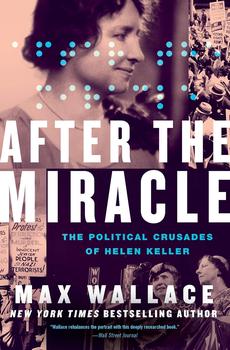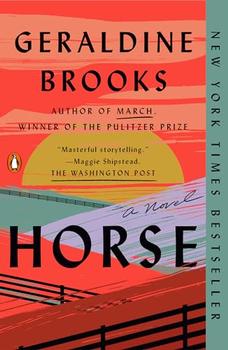Summary | Excerpt | Reviews | Beyond the book | Read-Alikes | Genres & Themes | Author Bio

The Woman Who Defied the Nazis in the World's Most Dangerous Horse Race
by Richard AskwithIn this well-researched biography, journalist Richard Askwith takes readers on a journey into 1930s Czechoslovakia as he follows the life of Lata Brandisova, the first and only woman to ever win the Grand Pardubice Steeplechase, also known as Velká Pardubická, a horse race that is widely considered to be the most dangerous in Europe. To read Brandisova's story is to be inspired. Female jockeys were unheard of at the time and she experienced intense male hostility on and off the track. In addition, the press regularly gossiped about her, focusing more on her hairstyles than her riding ability. In spite of the intense scrutiny she faced, she proved unbreakable and accomplished extraordinary feats that boosted her country's morale on the eve of World War II.
The biography clearly charts the course of Brandisova's life. She was born in 1895 and grew up in a small estate outside Prague, close to the fall of the Habsburg empire, a monarchy that collapsed in 1918 following the end of World War I. As a girl she fell in love with caring for her father's horses. Her father encouraged her passion and frequently rode with her. She won horses' trust by treating them respectfully, and even from an early age her talent for racing was obvious. By her twenties she regularly exercised a team of thoroughbreds, but still no one imagined that she would one day race professionally, least of all herself. Rules barring women from racing did not exist, but the practice was socially stigmatized.
The more Brandisova rode, however, the more determined she became to compete. Even more scandalously, she aspired to win the most difficult of all horse races, the Grand Pardubice. With the help of an influential cousin, she managed to participate—and place—in the race beginning in the late 1920s. Year after year she reentered the competition, and she eventually placed first on Sunday, October 1937, making history as the first woman to do so. Her victory humiliated Nazi leaders, who were determined to win the race, and defended Czechoslovakia's honor.
The biography skillfully contextualizes the jockey's life in relation to the politics of her time. She was born into an aristocratic family and enjoyed a privileged upbringing, but she lost her title as Countess during the First Republic, which formed after the Habsburg empire's end after WWI. Due to political reforms her family had to give up most of their land and capital, but her love for her homeland never diminished. As she pursued greatness and glory for Czechoslovakia, the nation faced intensifying hostility from Hitler's Germany, and many Czechs were growing pessimistic about the future. All of Europe was gearing up for war by the time she achieved victory in 1937, making the ensuing celebrations bittersweet. German riders had won the Grand Pardubice several times in the 1930s, and the country's leaders had expected them to do so again; they were as crushed by the defeat as the Czechs were uplifted. Germany invaded Czechoslovakia 17 months later; and Askwith presents strong evidence that suggests Brandisova's victory quickened Hitler's decision to conquer the country.
Horse racing enthusiasts will appreciate the author's detailed account of track history. In Chapter 4, for instance, he chronicles the origins of the Grand Pardubice in 1865. In vivid prose he recounts the harrowing details of the track's treacherous jumps and vast stretches of sprinting: "Even viewed on foot, many of the jumps make your blood run cold. In the heat and rush of the actual contest...they verge on the suicidal." He enumerates the race's many frightening features. The Snake Ditch is one especially memorable obstacle, which consists of "a wide, water-filled ditch with a drop of about two feet from take-off to landing." The chapter makes the incredible stakes of the course clear; later, readers immediately understand why the jockey's unexpected win made her a sensation overnight.
Brandisova was a remarkable woman who overcame cultural barriers at a critical moment of history. The author's admiration for his subject is palpable, and he paints a compelling portrait of her courageous, enigmatic spirit. When a reporter asked her why she was willing to put herself in such dangerous circumstances, she simply replied, "...I'm not all that attached to life."
![]() This review was originally published in The BookBrowse Review in October 2019, and has been updated for the
January 2021 edition.
Click here to go to this issue.
This review was originally published in The BookBrowse Review in October 2019, and has been updated for the
January 2021 edition.
Click here to go to this issue.

If you liked Unbreakable, try these:

by Max Wallace
Published 2024
In this powerful new history, New York Times bestselling author Max Wallace draws on groundbreaking research to reframe Helen Keller's journey after the miracle at the water pump, vividly bringing to light her rarely discussed, lifelong fight for social justice across gender, class, race, and ability.

by Geraldine Brooks
Published 2024
Winner of the 2022 BookBrowse Fiction Award
A discarded painting in a junk pile, a skeleton in an attic, and the greatest racehorse in American history: from these strands, a Pulitzer Prize winner braids a sweeping story of spirit, obsession, and injustice across American history.
It was one of the worst speeches I ever heard ... when a simple apology was all that was required.
Click Here to find out who said this, as well as discovering other famous literary quotes!
Your guide toexceptional books
BookBrowse seeks out and recommends the best in contemporary fiction and nonfiction—books that not only engage and entertain but also deepen our understanding of ourselves and the world around us.